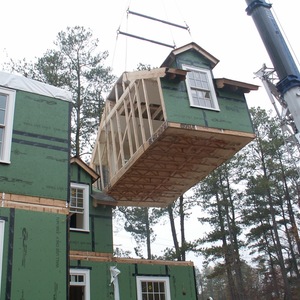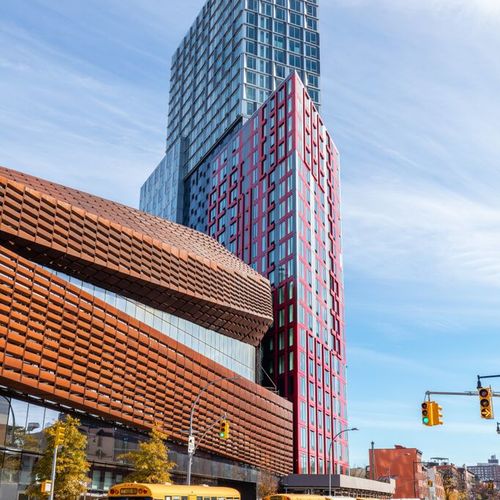
Marriott International is betting big on modular construction to overcome construction delays that have slowed expansion.
With 31 low-rise modular buildings already under its belt, the company has announced that it will build a 26-story modular hotel in New York City later this year.
In a news release, Marriott announced that the AC Hotel New York NoMad would include 168 rooms and stand 360 feet tall, making it the tallest modular hotel in the world. Each of the modules will arrive at the construction site completely finished — painted, furnished, and stocked with toiletries.
The building is being designed by Danny Forster, whom Marriott described as a leading advocate for modular construction.
Marriott said that it began exploring modular construction — in which components are built in off-site factories and assembled on the construction site — five years ago. Because of labor shortages, the time to build and open a hotel in North America had ballooned by as much as 50% since 2011. Since then, the company and its development partners have opened 31 Marriott-brand hotels that used prefabricated guest rooms and/or bathrooms.
It also began meeting with owners, franchise holders, architects, and others to promote the advantages of modular construction as a way of speeding up construction. Marriott also has hosted factory tours and “stacking events” to spread the word.
Marriott, based in Bethesda, Maryland, is the largest hotel chain in the world, operating 30 hotel brands internationally. In the U.S., its brands include Fairfield by Marriott, Courtyard by Marriott, AC Hotels, TownePlace Suites by Marriott, and SpringHill Suites by Marriott. To date, the largest modular building it has constructed is the 354-room Courtyard and TownePlace Suites in Hawthorne, California.
In New York, assembly is to begin in late fall and take about 90 days. In addition to the 168 room modules, the roof and rooftop bar on the $65 million building also will be made from modular components. The restaurant and lobby will be built with more traditional methods.
The company said that prefabrication not only reduces construction time but also cuts waste and noise at the site and makes for a higher-quality building. While the public spaces are being constructed on site, the guest rooms will be manufactured off site.
Forster said in prepared statement that it would be possible to build the hotel at the rate of a floor per day.
Prefab construction is getting more attention
Marriott thinks that modular construction holds great promise for the hotel industry, but interest in modular and panelized construction is growing on the residential side, too. Companies such as Ecocor, BrightBuilt Home, and Phoenix Haus produce high-performance houses with components built off-site. These and other companies point to the advantages of building components under cover — high quality because they are built in a controlled environment, and speedy on-site assembly.
Prefabricated houses are common in parts of Europe and have slowly picked up steam in the U.S.
But the technique is hardly novel, and it’s not nearly as simple as stacking Lego-like components into a completed structure, says building scientist John Straube. Speaking at the BuildingEnergy Boston conference in March, Straube said that prefabricated houses go as far back as the kit houses available in the early 1900s. There’s nothing new about claims that prefabricated construction is faster, cheaper, and better than conventional construction.
“Every one of these things can be true,” he said. “Every one of these things can be false.”
The industry is currently enjoying another spurt of interest, Straube said, but how well prefabrication lives up to its billing depends entirely on how the components are designed, built, and protected from the weather during transit. Prefabricated modules are especially vulnerable as they are being shipped to the assembly site, and manufacturers sometimes aren’t careful enough about protecting modules from rain and snow.
“Every step of the way,” he said, “they are vulnerable.”
As the components are assembled, the joints between parts, rather than the components themselves, are usually the areas where things go wrong, he said. Managing water, air, and thermal barriers is key.
Straube believes prefabricated construction will become more common in the future. Modular construction, he said, can help overcome labor shortages in remote areas, or in cities where labor tends to be very expensive. Overcoming labor problems is one of the chief reasons Marriott says it first got interested in modular construction.
But Straube scoffed at claims that erecting a building from modular pieces is as simple as stacking Legos. “It’s not at all like Legos,” he said. No matter how simple construction software like BIM makes the process look, in reality nothing is completely straight or plumb.
“The benefits can be real,” he said, “but that takes effort and that often means money.”
For the project in New York City, neither Marriott nor Danny Forster & Architecture was specific about construction details. It’s not known where the modules will be built or how big they are, how they will be stacked together and connected, and what the building’s mechanical systems will look like. Marriott didn’t respond to an email, and Danny Forster & Architecture didn’t return telephone calls.
Weekly Newsletter
Get building science and energy efficiency advice, plus special offers, in your inbox.















0 Comments
Log in or create an account to post a comment.
Sign up Log in